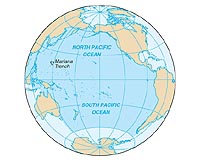| . |  |
. |
San Diego CA (SPX) Mar 15, 2010 The ongoing El Nino of 2010 is affecting north Pacific Ocean ecosystems in ways that could affect the West Coast fishing industry, according to scientists at NOAA and Scripps Institution of Oceanography, UC San Diego. Researchers with the California Cooperative Oceanic Fisheries Investigations (CalCOFI) at Scripps and NOAA's Southwest Fisheries Science Center report a stronger than normal northward movement of warm water up the Southern California coast, a high sea-level event in January and low abundances of plankton and pelagic fish - all conditions consistent with El Nino. Sea surface temperatures along the entire West Coast are 0.5 to 1 degree Celsius (0.9 to 1.8 degrees Fahrenheit) warmer than normal and at points off Southern California are as much as 1.6 degrees Celsius (2.9 degrees Fahrenheit) higher than normal. The most unusually high temperatures were mapped around Catalina and San Clemente islands. While strong winter storms caused an increase in coastal sea levels, scientists are investigating whether the higher sea levels are primarily a result of El Nino, a cyclical phenomenon characterized by warming eastern equatorial Pacific Ocean waters. "Based on our previous experience of El Nino in California, it is likely to reduce ocean production below normal, with possible effects extending to breeding failure of seabirds, and much lower catches in the market squid fishery," said Sam McClatchie, a fisheries oceanographer at NOAA's Southwest Fisheries. "However, predictions are never certain, and CalCOFI and NOAA ocean-observing systems will continue to provide essential monitoring of the situation." A combination of satellite remote sensing and field measurements is offering scientists a broader view of the evolution of this El Nino that was not available during previous El Ninos, which were especially strong in 1982-83 and 1997-98. Internet technology aboard CalCOFI research vessels is delivering that information faster. "You can post data the same day it's collected," said CalCOFI information manager Jim Wilkinson of Scripps Oceanography. "It used to take six months to work up some of the data and interpret it." NOAA Southwest Fisheries oceanographer Frank Schwing said scientists' analytical tools provide better ways to assess the strength of anomalies such as warming that are associated with El Nino. "We're taking a much more ecosystem-based approach to managing the system," said Schwing. "Because we are more on top of the observations, we can give a more timely heads-up to scientists and managers who are interested in the effects of El Nino." The two research centers use data collected by satellites and buoy-mounted instruments to measure sea surface temperature. CalCOFI researchers embark on quarterly cruises off the California coast to collect vertical temperature profiles in the upper reaches of the water column. They also count eggs of commercially important fishes such as sardines and anchovies as well as measure plankton volumes to estimate the amount of "production" available to marine organisms. NOAA's Advanced Survey Technologies Group assesses fish populations through acoustic surveys. In contrast with the last major El Nino, Scripps now deploys Spray gliders, diving robots that now gather ocean temperature and other data along transects between CalCOFI stations. The NOAA and CalCOFI scientists have observed a drop in biological abundance, or productivity, that appears to be related to the northward movement of warm water from the equator. The flow arrives in pulsing Kelvin waves that are detected by sea level and altimeter monitors and coastal tidal gauges. The layer of warm water often stifles the upwelling of nutrients from lower ocean depths that sustain larger populations of fishes and invertebrates. The researchers reported finding fewer hake and anchovy eggs than usual in the most recent CalCOFI surveys. Sanddab and flounder eggs dominated the samples. Most were collected in a small area east of the Channel Islands. The scientists added that if El Nino conditions continue, they are likely to be characterized by weaker than normal upwelling and lower biological production. El Nino conditions are forecast to persist into spring. If so, greater biological anomalies than have already been observed may develop.
Share This Article With Planet Earth
Related Links Scripps Institution of Oceanography Water News - Science, Technology and Politics
 Start planning for refugees from Pacific warming: scientist
Start planning for refugees from Pacific warming: scientistMajuro (AFP) Oct 19, 2009 Pacific islands in danger of being obliterated by rising sea levels should seek aid for relocation at a crunch UN climate change conference in Copenhagen, a Fiji-based scientist said. "By 2100, I don't see how many islands will be habitable," professor Patrick Nunn, a climate change researcher at the University of the South Pacific in Fiji said ahead of the opening of a regional climate chan ... read more |
|
| The content herein, unless otherwise known to be public domain, are Copyright 1995-2010 - SpaceDaily. AFP and UPI Wire Stories are copyright Agence France-Presse and United Press International. ESA Portal Reports are copyright European Space Agency. All NASA sourced material is public domain. Additional copyrights may apply in whole or part to other bona fide parties. Advertising does not imply endorsement,agreement or approval of any opinions, statements or information provided by SpaceDaily on any Web page published or hosted by SpaceDaily. Privacy Statement |